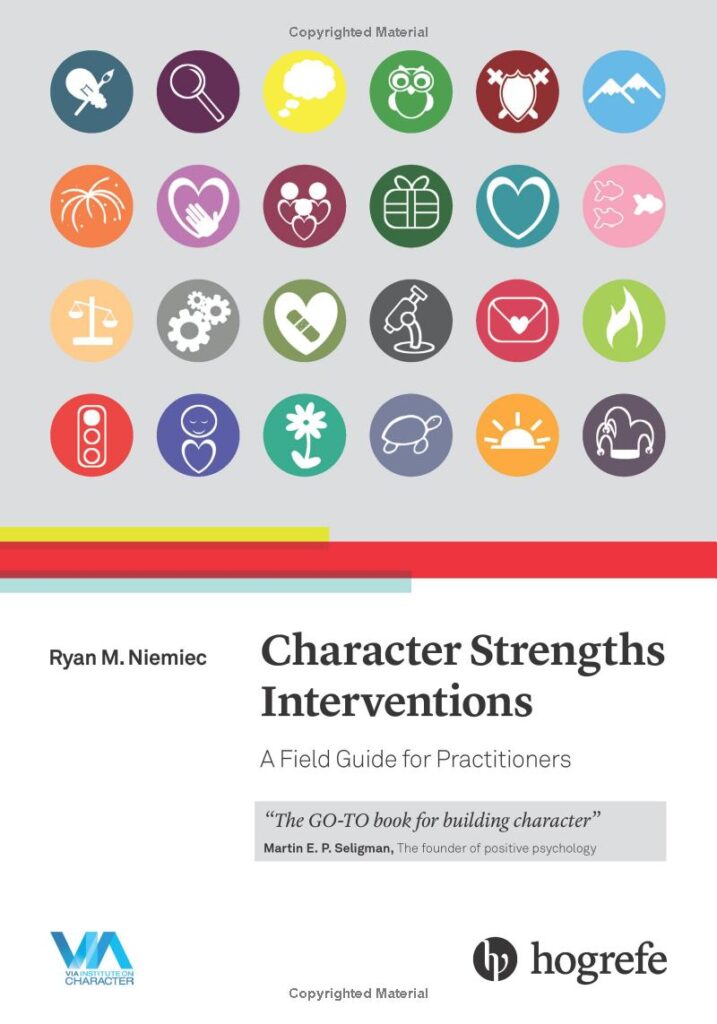
1 Line Summary
Character Strengths Interventions: A Field Guide for Practitioners is a book that provides practical guidance on how to use character strengths to improve people’s lives.
What Will You Learn
You’ll learn how to:
- identify character strengths and use them to advantage,
- develop your character strengths over time,
- use character strengths to overcome challenges and setbacks,
- build positive relationships and create a positive environment,
- boost self-confidence and live a more fulfilling life.
Best Quotations from the Book
- “The more we understand about character strengths, the better equipped we are to live good lives.”
- The best way to develop character strengths is to use them. The more you use a strength, the stronger it becomes.”
- “There are 24 character strengths, organized into six virtues: wisdom and knowledge, courage, humanity, justice, temperance, and transcendence.”
- “Character strengths interventions can be used in a variety of settings, including individual therapy, group therapy, coaching, and education.”
- “Character strengths interventions have been shown to be effective in improving a variety of outcomes, including happiness, well-being, and resilience.”
- “The most important thing to remember about character strengths interventions is that they are not a quick fix. They take time and effort to be effective.”
- “But if you are willing to put in the work, character strengths interventions can help you live a better, more fulfilling life.”
Book Summary
Character Strengths Interventions
Character strengths interventions are a type of positive psychology intervention that focuses on identifying, developing, and using character strengths.
- Character strengths are positive qualities that can be used to improve our lives.
- They include things like kindness, courage, and perseverance.
- Character strengths interventions can help us to identify our own strengths, learn how to use them more effectively, and overcome challenges.
Character strengths interventions can be used in a variety of settings, including individual therapy, group therapy, coaching, and education.
- They are most effective when they are tailored to the individual or group.
- The best way to find out if character strengths interventions are right for you is to talk to a therapist or coach who specializes in this area.
Character strengths interventions have been shown to be effective in improving a variety of outcomes.
These outcomes include:
- Increased happiness and well-being
- Improved relationships
- Increased resilience
- Reduced stress and anxiety
- Improved academic achievement
- Increased workplace productivity
VIA Classification of Strengths
The VIA Classification of Strengths is a framework developed by psychologists, Christopher Peterson and Martin Seligman. It identifies 24 character strengths, which are organized into six core virtues.
1. Wisdom
- Creativity: The ability to think of novel and valuable ideas and solutions.
- Curiosity: A strong desire to explore, learn, and seek new experiences.
- Open-Mindedness: Being receptive to different perspectives and ideas.
- Love of Learning: A passion for acquiring new knowledge and skills.
- Perspective: The capacity to see the bigger picture and understand the context of situations.
2. Courage
- Bravery: Acting in spite of fear, facing challenges with determination.
- Perseverance: Staying committed to goals and tasks despite obstacles.
- Honesty: Being truthful, transparent, and sincere in communication.
- Zest: Approaching life with enthusiasm, energy, and excitement.
3. Humanity
- Love: A strong affection and care for others, fostering deep connections.
- Kindness: The practice of being considerate, compassionate, and helpful.
- Social Intelligence: Understanding the emotions, needs, and motivations of others.
4. Justice
- Teamwork: Collaborating effectively with others toward common goals.
- Fairness: Treating all people equitably and impartially.
- Leadership: Guiding and motivating others toward shared objectives.
5. Temperance
- Forgiveness and Mercy: Letting go of resentment and showing compassion.
- Humility and Modesty: Avoiding arrogance and recognizing one’s limitations.
- Prudence: Practicing sound judgment and caution in decision-making.
- Self-Regulation: Exercising control over one’s emotions and actions.
6. Transcendence
- Appreciation of Beauty and Excellence: Noticing and valuing the beauty in life, nature, and the arts.
- Gratitude: Feeling and expressing thankfulness for life’s blessings.
- Hope: Believing in a positive future and working toward it.
- Humor: Finding and creating joy and laughter in everyday situations.
- Spirituality and Meaning: Seeking purpose and connection to something greater than oneself.
These 24 character strengths encompass a wide range of positive qualities that contribute to human flourishing.
Identifying Your Signature Strengths
Here’s a general outline of how one might identify their signature strengths:
Self-Reflection and Observation
- Identify your signature strengths starts with self-reflection and observation. Encourage yourself to think deeply about your life experiences and situations where you felt most fulfilled, engaged, or “in your element.”
- What were you doing during those moments, and what personal qualities or strengths were you naturally applying?
- Look for patterns and consistency in these experiences.
Utilize Character Strengths Assessments
- Character strengths assessments, such as the VIA Survey of Character Strengths, are often valuable tools.
- These assessments provide a structured and evidence-based approach to pinpointing your signature strengths.
Seek Input from Trusted Others
Others often see our strengths more objectively than we see them in ourselves. They can provide valuable insights into the qualities and behaviors they perceive as your signature strengths.
Observe What Energizes You
Signature strengths are often associated with activities that you find intrinsically rewarding.
Take note of the tasks or projects that you willingly invest time and effort into, as they can provide clues about your dominant strengths.
Character Strengths to Overcome Challenges
Character Strengths Assessment
Begin by identifying your character strengths. This often involves taking assessments like the VIA Survey of Character Strengths or consulting with a trained practitioner.
Understanding your unique strengths is the first step in any development process.
Strengths-Based Goal Setting
Set specific goals that revolve around leveraging and enhancing your character strengths.
Ensure that these goals are aligned with your values and aspirations.
Practice and Application
Deliberately practice using your character strengths in different situations.
Regularly applying your strengths helps you become more proficient in using them and integrates them into your daily life.
Feedback and Self-Reflection
Seek feedback from others to gain insight into how effectively you’re using your strengths. Self-reflection is also crucial.
Regularly assess your actions and decisions to see if they align with your strengths and values.
Adjust your behaviors and decisions accordingly to better align with your strengths.
How to use Character Strengths to Build Positive Relationships
Empathy and Understanding
Use your character strengths to enhance empathy and understanding in your relationships.
This not only demonstrates your empathy but also strengthens your connection with those around you.
Strengths Complementarity
Recognize the character strengths of the people you interact with. Strive to complement each other’s strengths in your relationships.
This synergy can foster stronger and more productive relationships.
Conflict Resolution and Appreciation
When conflicts arise, utilize your character strengths to navigate them constructively.
In moments of tension, reflect on your strengths, and consider how they can help you resolve conflicts peacefully and maintain the quality of your relationships.
Additionally, regularly express appreciation for others’ strengths and contributions. This reinforces positive interactions and strengthens the bonds you share.
How to use Character Strengths to Build Positive Environment
Identify and Leverage Strengths of Team Members
Start by recognizing and appreciating the character strengths of individuals within your team or organization. Encourage team members to take character strengths assessments like the VIA Survey.
Once you have an understanding of everyone’s strengths, strategically assign tasks and roles that align with their strongest attributes.
This not only maximizes individual contributions but also fosters a sense of fulfillment and engagement.
Promote a Strengths-Based Culture
Actively promote a strengths-based culture within your team or organization. Create an environment where individuals feel empowered to utilize their strengths regularly.
Encourage open discussions about strengths, and recognize and celebrate instances where character strengths contribute to success.
This can be done through regular team meetings, awards, or acknowledgment programs that highlight strengths-driven achievements.
Strengths-Based Collaboration
Facilitate collaboration that leverages the collective strengths of your team. Encourage team members to collaborate on projects and initiatives where their strengths can complement one another.
By fostering strengths-based collaborations, you create a dynamic and harmonious work environment.
Strengths in Problem-Solving and Innovation
When facing challenges or seeking innovation, turn to character strengths as valuable problem-solving tools. Encourage team members to brainstorm solutions that align with their strengths.
This approach not only generates creative solutions but also empowers individuals by making them feel their unique contributions are valued.
If you are a practitioner who wants to help individuals live happier, healthier, and more fulfilling lives, then you need to read Character Strengths Interventions.
Click to know “12 Rules for Life”, “The Six Pillars of Self Esteem” and “14 Essential Leadership Traits“


Pingback: “The Art of Racing in the Rain” by Garth Stein -